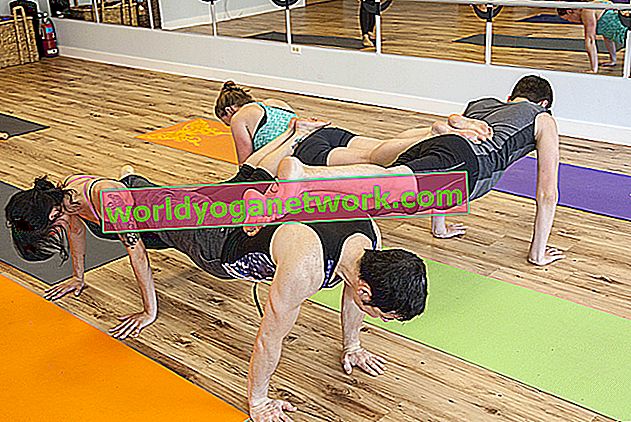
Bone loss is serious business. Both men and women reach their maximum bone mass around age 30. After that, it's a matter of maintaining what you've got, and no one is immune from the inevitable decline. If you're a woman approaching midlife, fasten your seat belt. You can lose up to 20 percent of your bone mass in the five to seven years after menopause, according to the National Osteoporosis Foundation. "Osteoporosis is the disease of denial,"says Sara Meeks, a Kripalu Yoga teacher since 1984 and a physical therapist specializing in osteoporosis. "Nobody thinks they have it, but, by a certain age, almost everyone does."
Bones are living tissue. The body breaks them down and builds them up in a constant flux that affects bone mass or density. While some bone loss is natural with aging, it's possible to maintain a healthy equilibrium, a balance of bone destruction and reconstruction. But if there's much greater loss than gain, osteoporosis (bone deterioration) can ensue.
The National Institutes of Health estimate that 10 million Americans have osteoporosis and another 34 million have osteopenia, low bone mass, that's often a precursor of osteoporosis. And, although men have it, too, when it comes to bone loss, women suffer more. Eighty percent of those with osteoporosis are women, and half of all women will have an osteoporosis-related fracture after age 50. Indeed, denial may seem like the only option for women seeing risk factors beyond their control, such as being thin and having a small build. But here's a wake-up call.
There are risk factors you can control, including diet and exercise. You can slow—and some studies suggest even reverse—bone loss by tackling it head-on, but it takes time and a concerted effort. And it turns out that yoga and a plant-based diet may be your strongest allies.
Get (Bone) Smart
Gina Martin, 52, of Knoxville, Tennessee, started doing a gentle yoga class years ago to relieve back pain. But in her early 40s, a test revealed she was suffering from the first signs of bone loss, and she jumped into action. A former nurse, Martin was used to taking her health into her own hands, so she traded her gentle hatha class for a more strength-building practice and revamped her diet to revolve around foods that enhance bone health, especially calcium-rich veggies like kale and spinach. To go the extra mile, she cut processed foods from her diet by refusing to buy anything with more than three ingredients.
But the change didn't happen overnight. "After a lifetime of eating mostly processed foods, it took me a year or so to make the shift,"Martin says. But her take-no-prisoners approach paid off. Five years later, her next scan showed improvement in bone density. Her last scan, in 2008, showed that her bone density was back to normal—no more osteopenia. "I remember my nurse technician was genuinely surprised," she says. "But I knew it was the diet and yoga."
Bone Builders
The more we learn about bone health, the more it seems that yoga plus a largely plant-based diet creates a foundation for healthy bones. For starters, yoga is a weight-bearing exercise, meaning you hold the weight of your body up against gravity. Resisting gravity puts a mild stress on the bones. That stress forces bones into laying down new growth. In this way, yoga is no different from jogging, walking, or playing tennis.
But unlike some other weight-bearing activities, yoga won't damage cartilage or stress the joints. Instead, it lengthens muscles and holds them there, creating tension on the bone.
"That pull of muscle on the bone is the single major factor in bone strength,"says Meeks. Consider, for example, Virabhadrasana I and Virabhadrasana II (Warrior Pose I and II). In both poses, the legs are weight bearing because they support the body's weight. "But by bending the front knee to 90 degrees, you do more than simply bear weight in the front leg; you magnify the force on the femur bone,"says Loren Fishman, MD, an assistant clinical professor at the Columbia College of Physicians and Surgeons in New York and the co-author of Yoga for Osteoporosis.
In Warrior II, you're also adding force to the shoulder joint. "Because you're holding your arms out away from your body, you're putting a lot more stress on the head of your humerus than you would if they were hanging at your sides."
Yoga's effects are difficult to measure by conventional medical standards, but Fishman published a small pilot study on bone loss and yoga in 2009. He enrolled 18 people with osteoporosis or osteopenia. (The average age was 68.) Everyone had a baseline bone-density test at the start. While 7 people acted as the control group, 11 others learned a sequence that included 10 yoga postures, including Trikonasana (Triangle Pose), Adho Mukha Svanasana and Urdhva Mukha Svanasana (Downward- and Upward-Facing Dog poses), and Setu Bandha Sarvangasana (Bridge Pose). Participants stayed in each pose for 20 to 30 seconds. (Research suggests that roughly 10 seconds of stimulation is enough to trigger new bone growth.) The daily yoga routine took about 10 minutes.
Fishman charted both groups' progress and, two years later, asked everyone to get another bone scan. The results, published in the journal Topics in Geriatric Rehabilitation, were promising. While nearly every member of the control group either maintained or lost bone, roughly 85 percent of the yoga practitioners gained bone in both the spine and the hip. "I was shocked at the results,"he says. "By putting tremendous pressure on the bones without harming the joints, yoga may be the answer to osteoporosis."
Food Factor
While Martin saw her bone density increase after she started taking two or three two-hour Power Yoga classes a week, she also fills up on vegetables. For lunch she makes a colorful salad with lettuces, fresh berries, mango, pine nuts, dried cranberries, and raw kale chopped superfine like parsley. And while she doesn't shun dairy, fish, or animal products—she eats a bit of cheese every day, drinks cream in her coffee—even when she and her husband eat out for dinner (which is often), she always orders a couple of vegetable sides in addition to a small serving of protein-rich food.
This balance is likely a big contributing factor to the improvement in her bones. Some research shows that too much protein in the diet may actually weaken bone. That's because protein is acid forming. When too much acid enters the bloodstream, the body pulls calcium, which is alkaline, from bone to neutralize it.
"We absolutely see a strong correlation between a plant-based diet and bone mineral density,"says Annie Kay, MS, RD, an integrative dietician at Kripalu Center for Yoga & Health, a yoga therapist, and the former director of the osteoporosis awareness program at the Massachusetts Department of Public Health. "Most Americans eat twice as much protein as their bodies need, so there is a big acid push in the body that causes it to excrete too much calcium."
Consuming large amounts of fruits and vegetables may help right this imbalance. "All of those fruits and vegetables neutralize the acid from protein,"says Lynda Frassetto, MD, a kidney-disease specialist at the University of California, San Francisco, and the principal author of a cross-cultural study on how protein in the diet impacts bone health. Published in 2000 in the Journal of Gerontology, her trial looked at diet and hip-fracture data from 33 countries. She found a direct link between high consumption of animal protein and a higher number of hip fractures in women age 50 and older.
Given Frassetto's findings, the temptation is to make a sweeping generalization that animal protein is "bad"and plant protein is "good,"but unfortunately, it's not that simple. Indeed, all forms of protein have the potential to be acid forming, whether it's a hamburger or a veggie burger. What's important is the ratio of your intake of fruit and vegetables to your intake of animal protein, says Frassetto.
Move It or Lose It
If you want to prevent bone loss, any amount of yoga is likely to be better than no yoga. The people in Fishman's study got bone benefits with as little as 10 minutes of yoga a day. That said, more is probably better than less. If you are an experienced yogi and you are looking to either prevent or reverse early-stage bone loss, like Martin, almost any yoga practice that involves a series of standing postures (flow or no) will do the trick.
But if you're a beginner with osteopenia or you have osteoporosis, take time to find an experienced teacher who is trained in a style of yoga that focuses on alignment and safety (stick to beginner offerings). Explain your situation before the class starts and make sure the teacher has some knowledge of yoga therapeutics or, at the very least, the contraindications for osteoporosis.
Yoga can be a bone saver, but it can also be detrimental if it isn't practiced correctly. For instance, in someone with osteoporosis, forward bending (flexion of the spine)—which is a big part of the average yoga class—can increase the likelihood of spinal fracture by excessively loading the front of the vertebrae compared with your back.
Twists are another potential danger zone because they can put the spine in a vulnerable position. Meeks prefers supine twists. That way, the spine is fully supported and elongated. Carol Krucoff, co-director of the Therapeutic Yoga for Seniors teacher training program at Duke Integrative Medicine in Durham, North Carolina, advises her students with bone loss against "end-range"or deep twists (see sidebar above for pose suggestions).
Wenn Sie sich jedoch noch im Präventionsmodus befinden, sind alle Posen zu gewinnen, einschließlich Vorwärtsbiegungen, Rückbiegungen, Drehungen und Inversionen. Und es ist nie zu früh, um Knochen zu retten. "Wenn Sie die Knochen aufbauen, während Sie jung sind", sagt Fishman, "können Sie es sich leisten, mit zunehmendem Alter ein wenig zu verlieren."
Gutes Essen
Wenn Sie Ihre Ernährung mit alkalireichen Früchten füllen und saure Lebensmittel auf ein Minimum beschränken, bleiben Ihre Knochen gesund und stark.
Füllen Sie diese aus:
- Säurearme (alkalische) Lebensmittel
- Trockenobst
- Gemüse (insbesondere Brokkoli, Kohl, Tomaten, Grünkohl und Zucchini)
- Frisches Obst (insbesondere Äpfel, Ananas, Bananen, Orangen und Pfirsiche)
Begrenzen Sie diese:
- Säurereiche Lebensmittel
- Käse
- Fleisch
- Eier
- Fisch
Bust a Move, kein Knochen
Wenn Sie sich in einem frühen Stadium des Knochenschwunds befinden, zeigen einige Untersuchungen, dass Sie den Zustand mit nur 10 Minuten Yoga pro Tag verlangsamen und sogar umkehren können. Während es immer eine gute Idee ist, einen erfahrenen Lehrer zu suchen, sind die folgenden Posen (empfohlen von Loren Fishman, Sara Meeks und Carol Krucoff) ein großartiger Ausgangspunkt. Ziel ist es, Kraft und Gleichgewicht aufzubauen und gleichzeitig Stabilität und Sicherheit zu maximieren. Diese Posen sind per se nicht als Serie konzipiert, sondern können in eine Heimübung integriert oder als Ersatz für Studioklassen verwendet werden, wenn alle anderen eine tiefe Drehung oder Vorwärtsbeugung ausführen.
Stärken Sie Ihr Skelett mit diesen 7 Posen:
1. Vrksasana (Baumpose)
2. Utkatasana (Stuhlhaltung)
3. Bhujangasana mit Armen an den Seiten (Cobra Pose)
4. Setu Bandha Sarvangasana (Brückenhaltung)
5. Virabhadrasana I (Kriegerpose I)
6. Virabhadrasana II (Krieger II)
7. Abwechselndes Anheben von Arm und Bein (auf allen Vieren beginnen und gegenüberliegenden Arm und Bein anheben und ausfahren)


